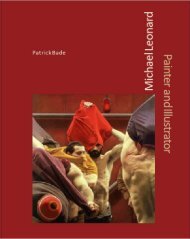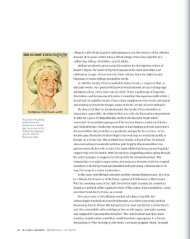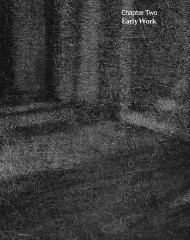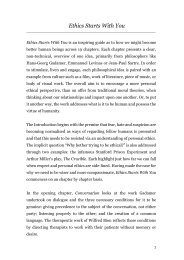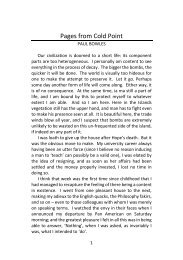You also want an ePaper? Increase the reach of your titles
YUMPU automatically turns print PDFs into web optimized ePapers that Google loves.
14 from refugees <strong>to</strong> royalty<br />
clothing. Meyer was warned <strong>to</strong> abide by the regulations in future but escaped<br />
further punishment.<br />
The next mention comes from the year 1600, when a Schutzjude – a ‘protected<br />
Jew’ – named Joseph of Messel petitioned the authorities in nearby Hanau for<br />
permission <strong>to</strong> move there and place himself under the protection of its ruler,<br />
Count Philipp Ludwig II. For Jews, obtaining this grant of protection from the<br />
local sovereign was an essential condition of residency. As a Schutzjude already,<br />
Joseph was living in Messel under the protection of Baron Heinrich von Groschlag.<br />
We have no record of whether his petition <strong>to</strong> move <strong>to</strong> Hanau was successful.<br />
There was a major influx of Jewish families <strong>to</strong> Messel during the eighteenth<br />
century, so that by the time of the 1781 census one in every six households in<br />
the village was Jewish. In 1813 there were eighty‐one Jews registered out of a<br />
population of 663 in Messel, or just over 12 per cent. 3 To put these figures in<br />
context, the 175,000 Jews who lived in all German states at the beginning of<br />
the nineteenth century represented less than 1 per cent of the <strong>to</strong>tal population.<br />
Confident in its strength, the Jewish community in Messel applied in 1739 <strong>to</strong> build<br />
a synagogue in the centre of the village – one of the very first village synagogues<br />
<strong>to</strong> be constructed in the region. The building served as a place of worship and a<br />
Jewish school until 1830 when a new synagogue was built around the corner.<br />
Despite these achievements, life for the Jewish community of Messel was still<br />
restricted by fixed boundaries of exclusion and privation. Jews were treated as<br />
an alien presence in the village, their community looked upon as a foreign colony<br />
living side by side with the Christian majority. Jewish men were excluded from<br />
all guild professions and thus could not engage in any form of manufacturing or<br />
handicraft production. While some could fall back on money‐lending, the vast<br />
majority earned a living through petty trade in old clothes, ironware and other<br />
second‐hand goods. With all Jews forced in<strong>to</strong> the same occupations, competition<br />
was intense and margins were thin, so that only the most successful were able <strong>to</strong><br />
escape poverty. Crucially, most Jews were barred from owning land or property,<br />
which made them a welcome source of rent for Christian landlords, just as their<br />
exclusion from farming – the main occupation of Messel villagers – left them<br />
dependent on buying food from their non‐Jewish neighbours. 4<br />
The family that would eventually carry the name Messel <strong>to</strong> the wider world<br />
settled in the village during the eighteenth century. The first known member of the<br />
family is Aharon Leib Bentheim, born in 1723 and sometimes referred <strong>to</strong> as Aron<br />
Löb. His is the older of the two <strong>to</strong>mbs<strong>to</strong>nes in the Jewish cemetery of Dieburg.<br />
The fact that he and his four sons all went by the surname Bentheim indicates<br />
that the family came from the county of that name on the Dutch border in Lower<br />
Saxony, where there had been an established Jewish community since at least the<br />
seventeenth century. The feudal rulers of Bentheim looked on the Jews as a ready




